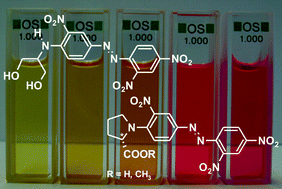Solvatochromism and linear solvation energy relationship of diol- and proline-functionalized azodyes using the Kamlet–Taft and Catalán solvent parameter sets†
Abstract
New donor–acceptor-substituted azo

* Corresponding authors
a
Department of Polymer Chemistry, Institute of Chemistry, Chemnitz University of Technology, Strasse der Nationen 62, Chemnitz, Germany
E-mail:
stefan.spange@chemie.tu-chemnitz.de
Fax: +49 (0)371-531-21230
Tel: +49 (0)371-531-21239
b Department of Inorganic Chemistry, Institute of Chemistry, Chemnitz University of Technology, Strasse der Nationen 62, Chemnitz, Germany
New donor–acceptor-substituted azo

 Please wait while we load your content...
Something went wrong. Try again?
Please wait while we load your content...
Something went wrong. Try again?
K. Hofmann, K. Schreiter, A. Seifert, T. Rüffer, H. Lang and S. Spange, New J. Chem., 2008, 32, 2180 DOI: 10.1039/B809055F
To request permission to reproduce material from this article, please go to the Copyright Clearance Center request page.
If you are an author contributing to an RSC publication, you do not need to request permission provided correct acknowledgement is given.
If you are the author of this article, you do not need to request permission to reproduce figures and diagrams provided correct acknowledgement is given. If you want to reproduce the whole article in a third-party publication (excluding your thesis/dissertation for which permission is not required) please go to the Copyright Clearance Center request page.
Read more about how to correctly acknowledge RSC content.
 Fetching data from CrossRef.
Fetching data from CrossRef.
This may take some time to load.
Loading related content
